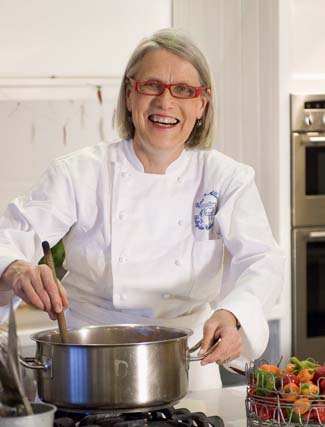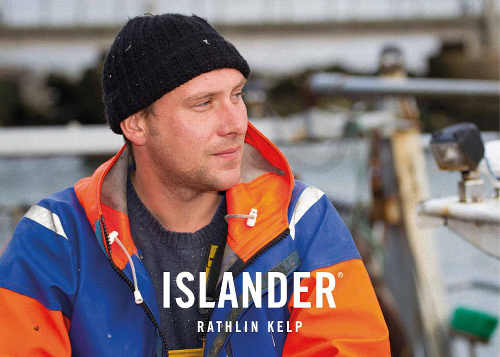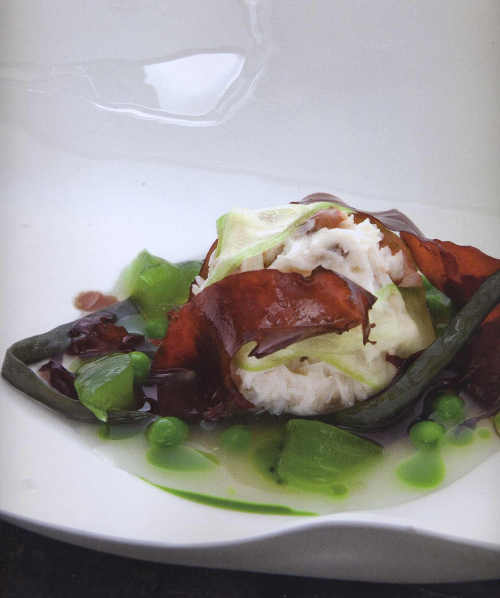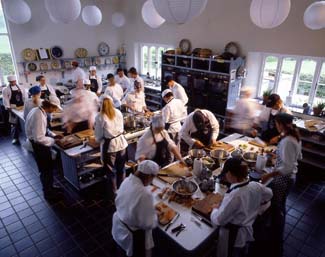The Darina Allen Column

We’ve gone crazy for seaweed in recent times, says Darina, and now she’s really woken up to phenomenal variety of sea vegetables around our coast.
We were always big fans (and still are) of carrageen moss and dillisk, but that was pretty much the limit of my knowledge of seaweeds up to relatively recently.
Dr Prannie Rhatigan whetted my appetite when she wrote Irish Seaweed Kitchen in 2009. Occasionally, I would meet Olivier Beaujouan of On the Wild Side on his market stall in Kenmare or at food festivals around the country — Olivier, from France, had an innate knowledge of seaweed and was permanently perplexed as to why we Irish didn’t seem to be excited or knowledgeable about the wealth of free and delicious food along our coast lines. Since 1999 he has been selling seaweed tapenade and sea spaghetti at farmers markets to his devotees and chefs.
More recently several companies, including Algaran Seaweed Products in Donegal and Wild Irish Sea Veg in Clare have developed very successful seaweed processing companies and there’s lots more in the pipeline.
The big breakthrough for me was when Sally McKenna, who wrote the excellent book Extreme Greens: Understanding Seaweeds, explained that all seaweeds are edible; some may not be particularly palatable to nibble but none are poisonous and they are all immensely nutritious. Ever since I’ve been prowling along the coastline and seashore snipping and nibbling and having so much fun.
We’re making seaweed salads, adding seaweed to bread, sauces, stews and drinks, sometimes fresh, sometimes dried, always with interesting and mostly delicious results. Recently I met Kate Burns whose family have lived and fished sustainably on Rathlin Island off the coast of Antrim for four generations.
Kate with a ton of letters after her name has been involved in rural and marine development not just in Ireland and the UK but also in Cyprus, Estonia, Latvia and Lithuania for decades.
 She introduced me to Rathlin Island kelp which is being harvested sustainably by her son Benji McFaul of Islander Rathlin Kelp in the same time honoured way as it was by his father, grandfather and great grandfather before him.
She introduced me to Rathlin Island kelp which is being harvested sustainably by her son Benji McFaul of Islander Rathlin Kelp in the same time honoured way as it was by his father, grandfather and great grandfather before him.
The cold waters are clean and pure due to the mix of Irish Sea and Atlantic currents. It comes ready to use in packets, shredded like fettuccini and I love it. The environment creates ideal conditions for growing kelp.
The McFaul family are well known for their commitment to the caring for the environment. Benji’s father Jim and brother Fergus won Northern Ireland organic farmers of the year in 2010 and their fishing and seafood business follows responsible harvesting principals.
Kelp is amazing stuff, it has more calcium, iron and roughage than any other vegetable —it’s a kind of a wonder food. I know I advise people against buying anything that makes a health claim but this time I really believe it.
There are three types of kelp — alaria, digitata and laminaria saacharina — you can get it from Wild Irish Seafood fresh or frozen, noodle cut, salad cut and wraps.
Kelp is just one of the myriad of seaweeds around our coast. We also love pepper dillisk, sea lettuce, sea spaghetti, kombu. We’re no longer surprised to find stinging nettles, elderflowers or dandelion leaves on restaurant or country pub menus so watch that space because many chefs have discovered the magic of seaweeds and are having lots of fun. Meanwhile you too can experiment.
 RECIPE: Brown Crab with Pickled Red Dulse Seaweed, Cucumber with Summer Peas and Coriander Oil
RECIPE: Brown Crab with Pickled Red Dulse Seaweed, Cucumber with Summer Peas and Coriander Oil
Taken from Chapter One, an Irish Food Story, by Ross Lewis
‘We know summer is here when the best crab starts to arrive, matched by sweet tasting seasonal peas. We get a wonderful crop of seaweed from Manus McGonagle in Donegal. We pickle it and combine it with cucumber jelly, so this dish is fresh, summery and salty, with a sweetness from the crab. There is a deep umami flavour from the seaweed with the sweet-popping peas and the cucumber jelly makes it a real summer favourite at the restaurant for the crab.’
2 litres water
40g salt
1kg crab claws
Splash of spirit vinegar
40g mayonnaise (Ross uses an egg white mayo (see hot tips for details of Chapter One book)
1 spring onion, very finely sliced
1 tbsp finely chopped fresh chives
4 drops Tabasco sauce
Juice of ½ lemon
Pinch of cayenne pepper or smoked sweet paprika
For the cucumber jelly:
1½ gold leaf gelatine leaves
2 cucumbers
2 tsp mirin
1 tbsp light soy sauce
2g salt
For the marinated cucumber:
1 cucumber
1 tbsp mirin
For the fresh peas:
50g shelled fresh peas
To serve:
125g pickled red dulse and sea spaghetti
About 2 tsp coriander oil, in a small
squeezy bottle
400ml crab juice
CRAB
Put the water in a large pan with the salt and vinegar, and bring to the boil.
Blanch the crab claws. For medium claws, cook for 5 minutes; if they are larger or smaller, add or subtract a minute. Lift out and transfer into iced water.
When cool use the back of a heavy knife to gently crack the shells and remove the meat, picking out any bits of shell. (This amount of crab claws should yield at least 200g of meat.)
In a bowl, combine the crab with the mayonnaise, spring onion and chives.
Season with the Tabasco, lemon juice, cayenne pepper or paprika and a pinch of salt.
CUCUMBER JELLY
Put the gelatine into a bowl of cold water and set aside. Juice the cucumbers, skin on, and pass the juice through a double layer of muslin.
Measure out 200ml of juice and add the mirin, soy sauce and salt, mixing well and checking the seasoning.
Heat 100ml of the mixture in a small pan until hot but not boiling and then take it off the heat.
Gently squeeze the gelatine to remove excess water and whisk it into the hot cucumber juice.
When dissolved combine with the rest of the mixture and whisk together.
Pour into a bowl and place in the fridge to set.
MARINATED CUCUMBER
Square off the cucumber and use a mandolin to cut it into ribbons — you’ll need 3 per portion.
Lay the cucumber ribbons on a tray and sprinkle over a teaspoon of salt and the mirin.
Leave for an hour and then freeze, covered with clingfilm. Remove from the freezer 10 minutes before serving, then drain, reserving the liquid.
Bring a small pan of water to the boil and prepare a bowl of iced water.
Blanch the peas until just cooked and refresh in the iced water, then drain.
SERVING
Spoon an eighth (about 30g) of the crab mayonnaise mixture into the centre of each shallow serving bowl.
Put 3 pieces of the marinated cucumber on top of this and then add 2–3 pieces of the pickled red dulse on the crab and 2 pieces of the sea spaghetti around the plate.
Use a teaspoon to put small spoonfuls of cucumber jelly around the plate and add a few of the peas.
Finish with a little of the reserved cucumber liquid, 4–5 spoonfuls of crab juice and some dots of coriander oil around the crab.
PICKLED RED DULSE OR SEA SPAGHETTI
Makes 150g
150g red dulse or sea spaghetti
600ml rice vinegar
4g salt
40g sugar
3g lemon zest
Wash the red dulse or sea spaghetti and carefully sort through it, discarding any damaged pieces. Put the rice vinegar in a pan large enough to hold all the ingredients, and add the salt, sugar and lemon zest. Bring to the boil, stirring to dissolve the sugar, and add the red dulse or sea spagetti. Return to the boil and simmer for about 5 minutes until tender. Remove from the heat and allow to cool before serving.
DILL, CHIVE, BASIL, CORIANDER OR ROCKET OIL
Makes about 400 ml
500 g fresh herb leaves (dill, chive, basil, coriander or rocket)
400 ml light olive oil or any neutral oil like rapeseed
Blanch the herb sprigs in boiling unsalted water, lift out using a spider and refresh in a bowl of iced water. Drain and squeeze really tightly in a cloth, draining off as much of the water as you can. This will give you approximately 150g of blanched herb. Combine this with 400ml of oil in a Pacojet container and freeze overnight.
The next day, blend 2–3 times and hang in a muslin. The result is a deep green and strong herb-flavoured oil. If you haven’t got a Pacojet, half the quantities, so use 250g of fresh herb sprigs and 200ml light olive oil or any neutral oil like rapeseed. Blend together on a high speed for 3–4 minutes and hang in a muslin. Using a funnel, put into a squeezy bottle. These will keep for up to 1 week.
CRAB JUICE
Add a little thickener, a pinch at a time, to a crab stock until slightly thickened. Use as required.
'30 Years at Ballymaloe' - Bord Gáis Avonmore Cookbook of the Year 2013
Good Food Ireland Cookery School of the Year 2012/2013
Ballymaloe Literary Festival of Food and Wine 15- 17th May 2015
www.litfest.ie
***
 The Ballymaloe Cookery School in East Cork has a great programme of cookery courses for all interests and abilities running throughout 2014. Ranging from a relaxing visit to sit in on an afternoon cookery demonstration to a week long ‘Intensive Introductory Course’.
The Ballymaloe Cookery School in East Cork has a great programme of cookery courses for all interests and abilities running throughout 2014. Ranging from a relaxing visit to sit in on an afternoon cookery demonstration to a week long ‘Intensive Introductory Course’.
Sitting in the middle of a 100 acre organic farm the Ballymaloe Cookery School provides its students not only with a life skill learnt under the expert tutelage of their very capable teachers but also a place to relax and unwind from the stresses and strains of normal everyday life. The cottage accommodation available onsite for residential courses consists of a collection of delightful converted outbuildings which have been transformed over the years by the Allens, and other accommodation is available locally for the short courses.
www.cookingisfun.ie





There are currently no comments
Leave a comment
Not a member? Register for your free membership now!
Or leave a comment by logging in with: